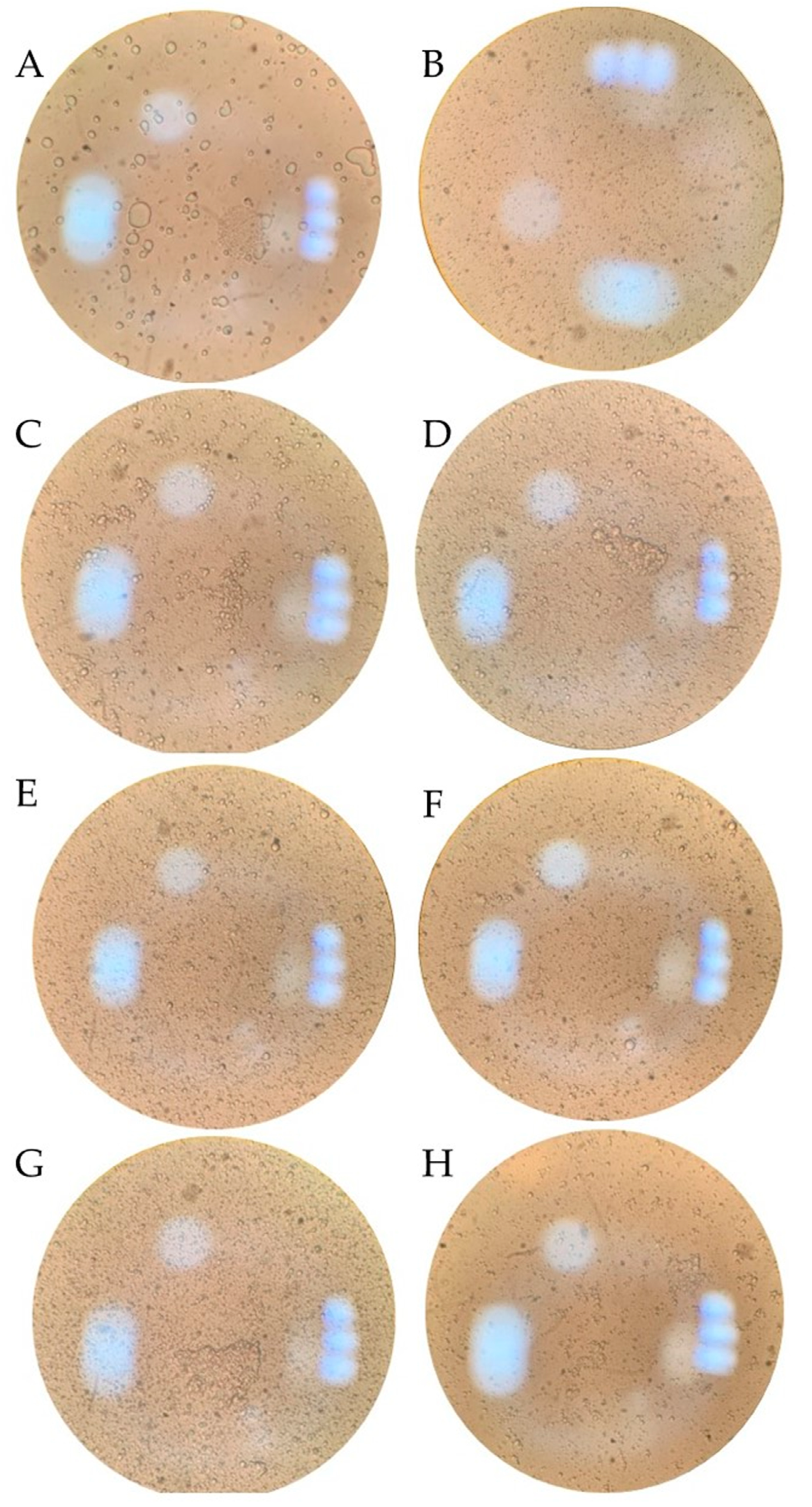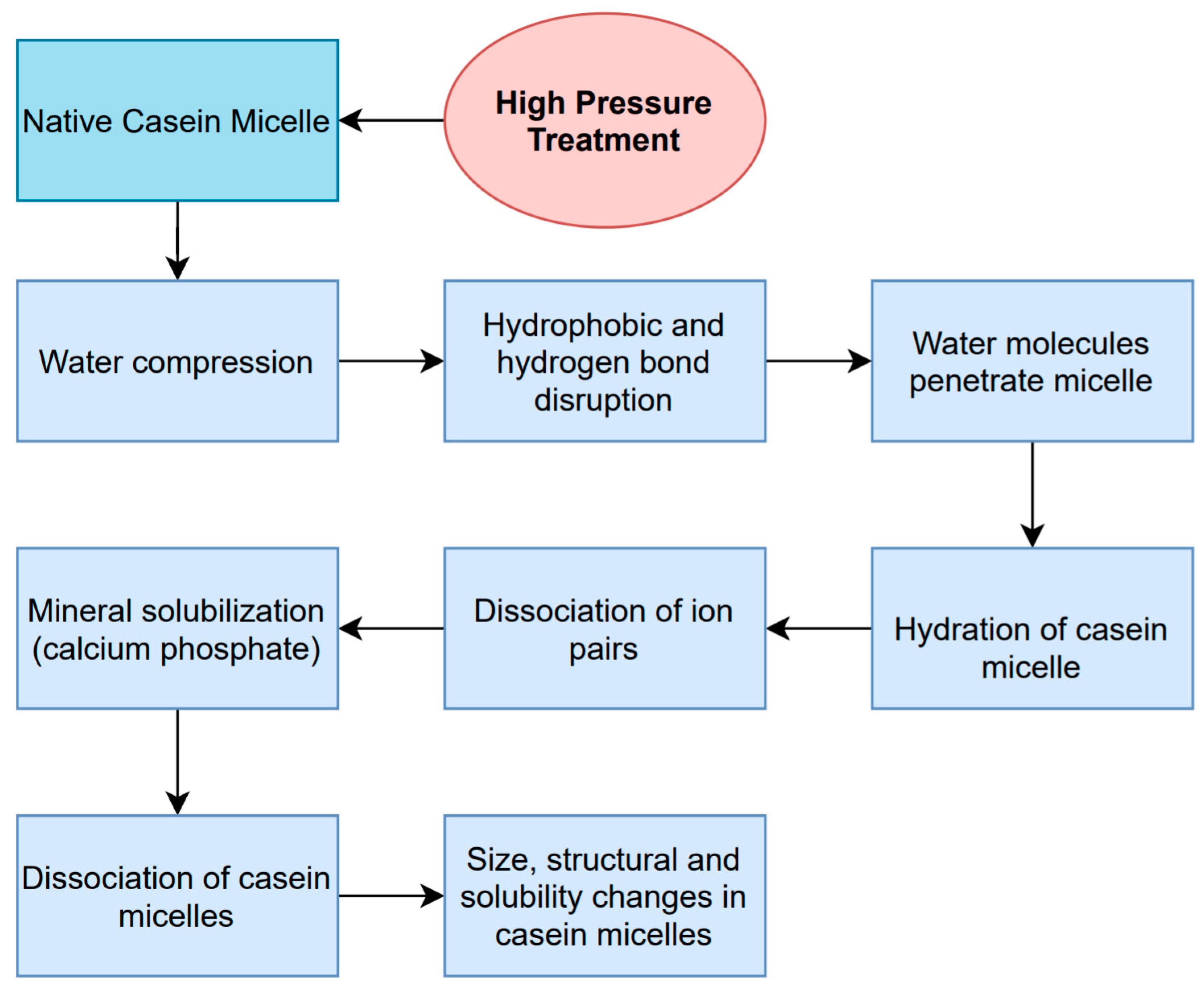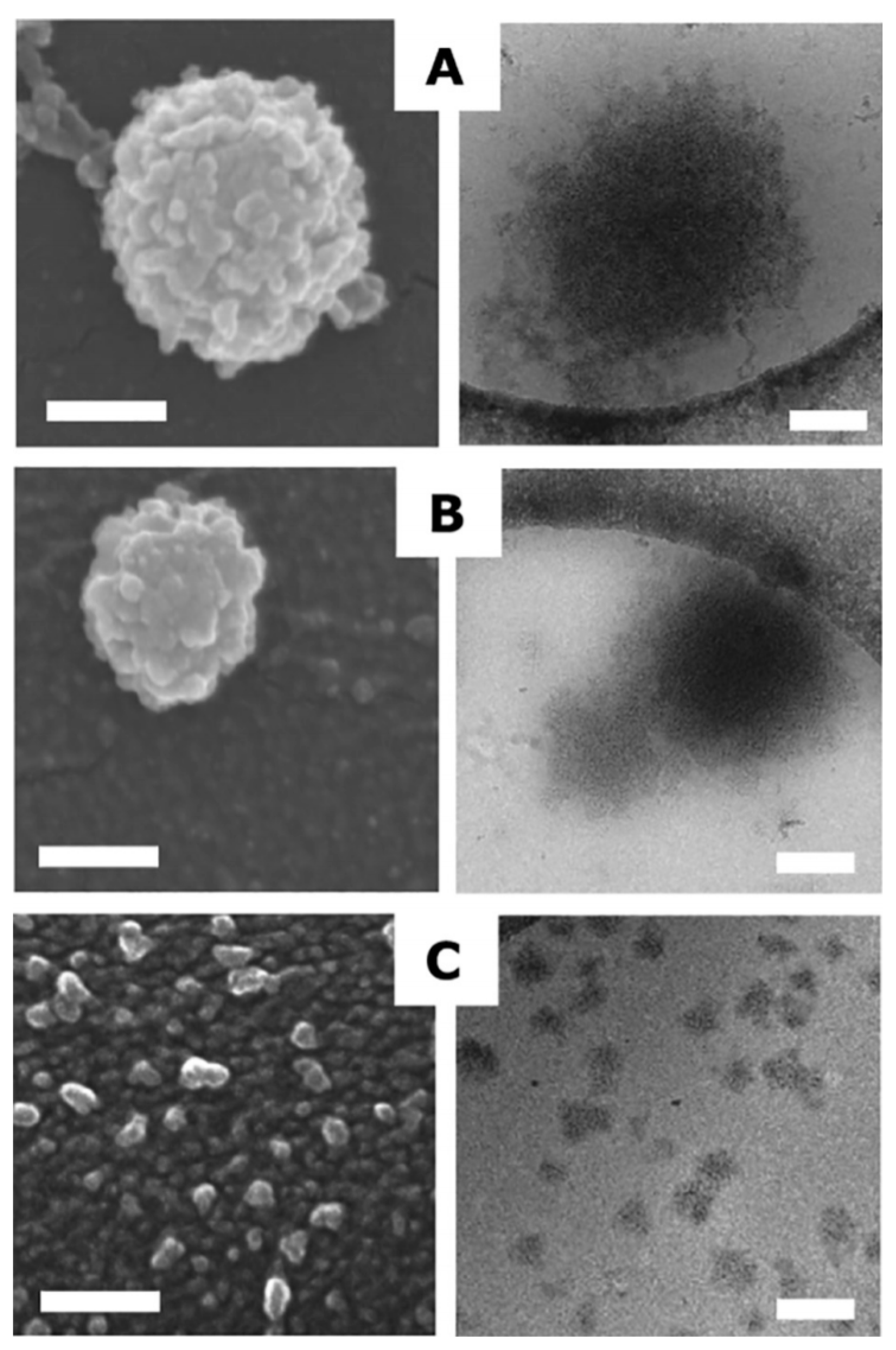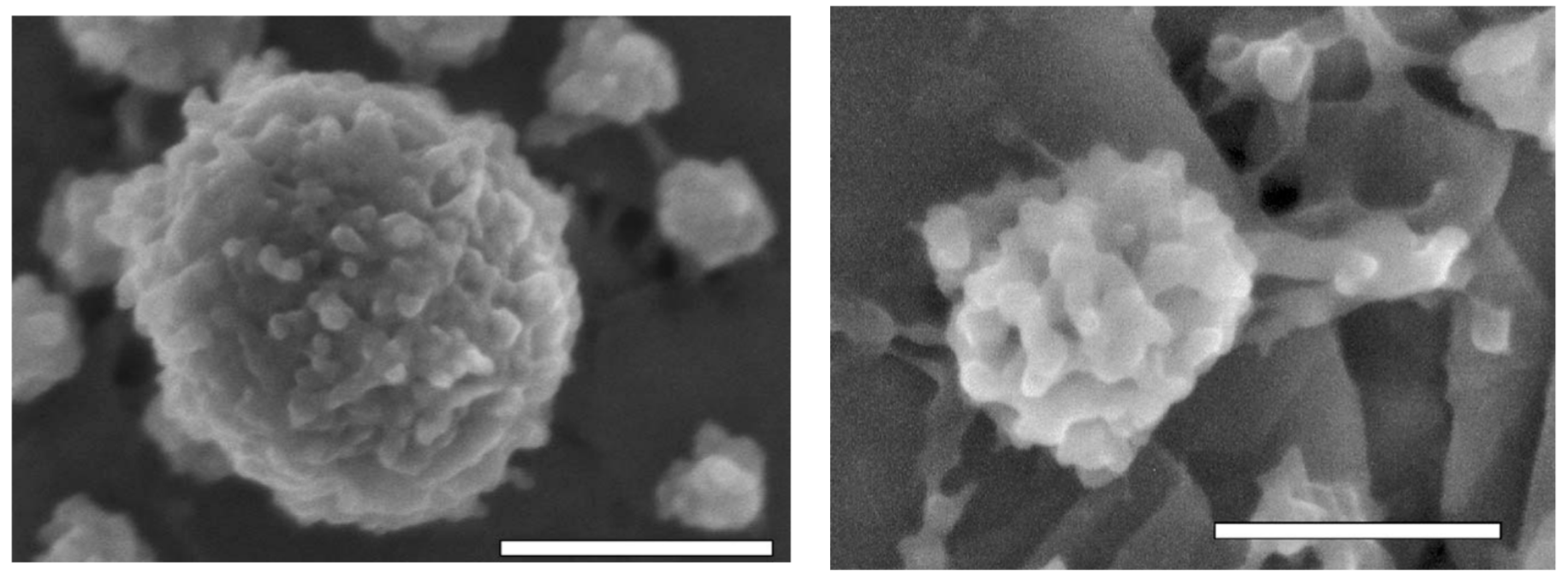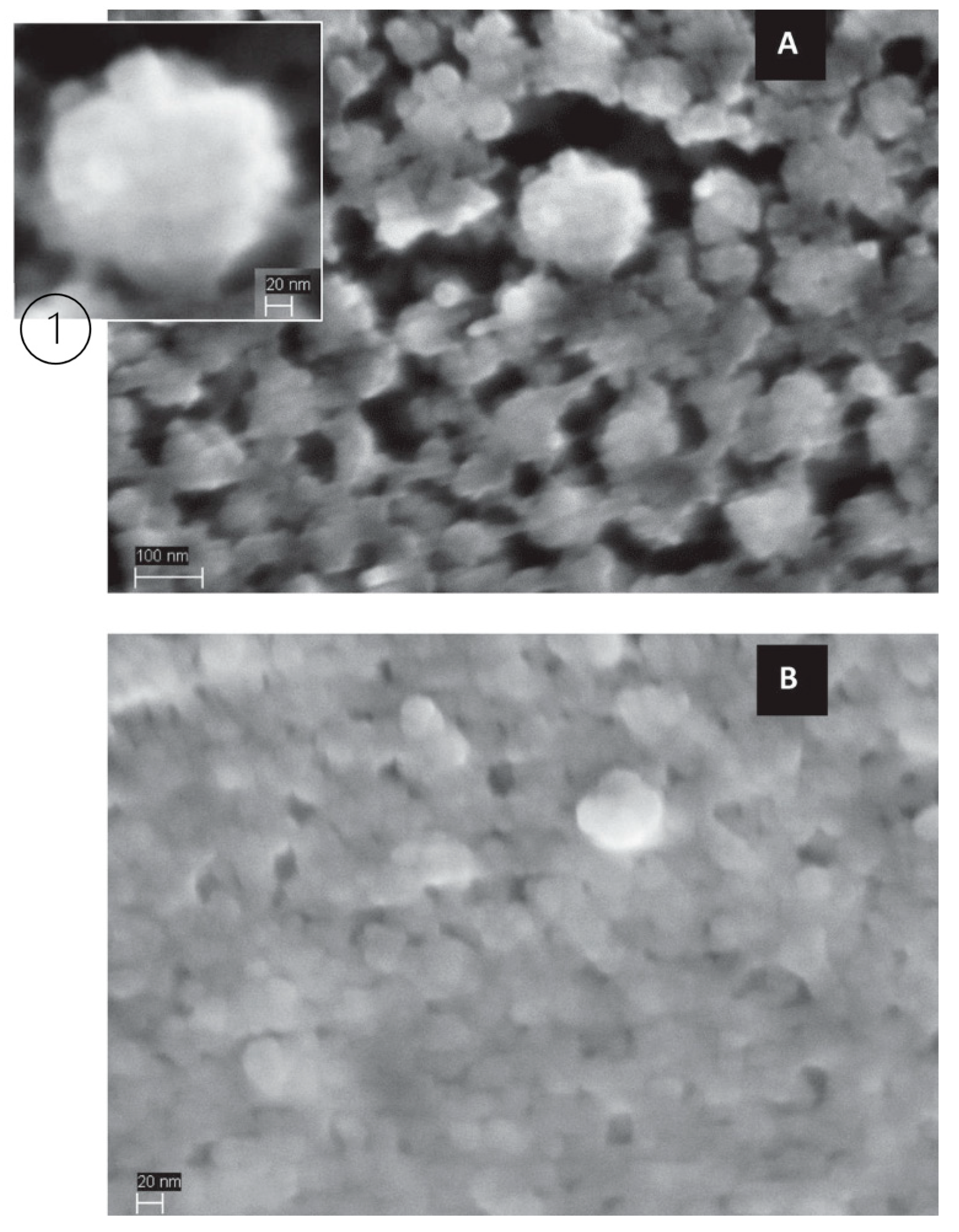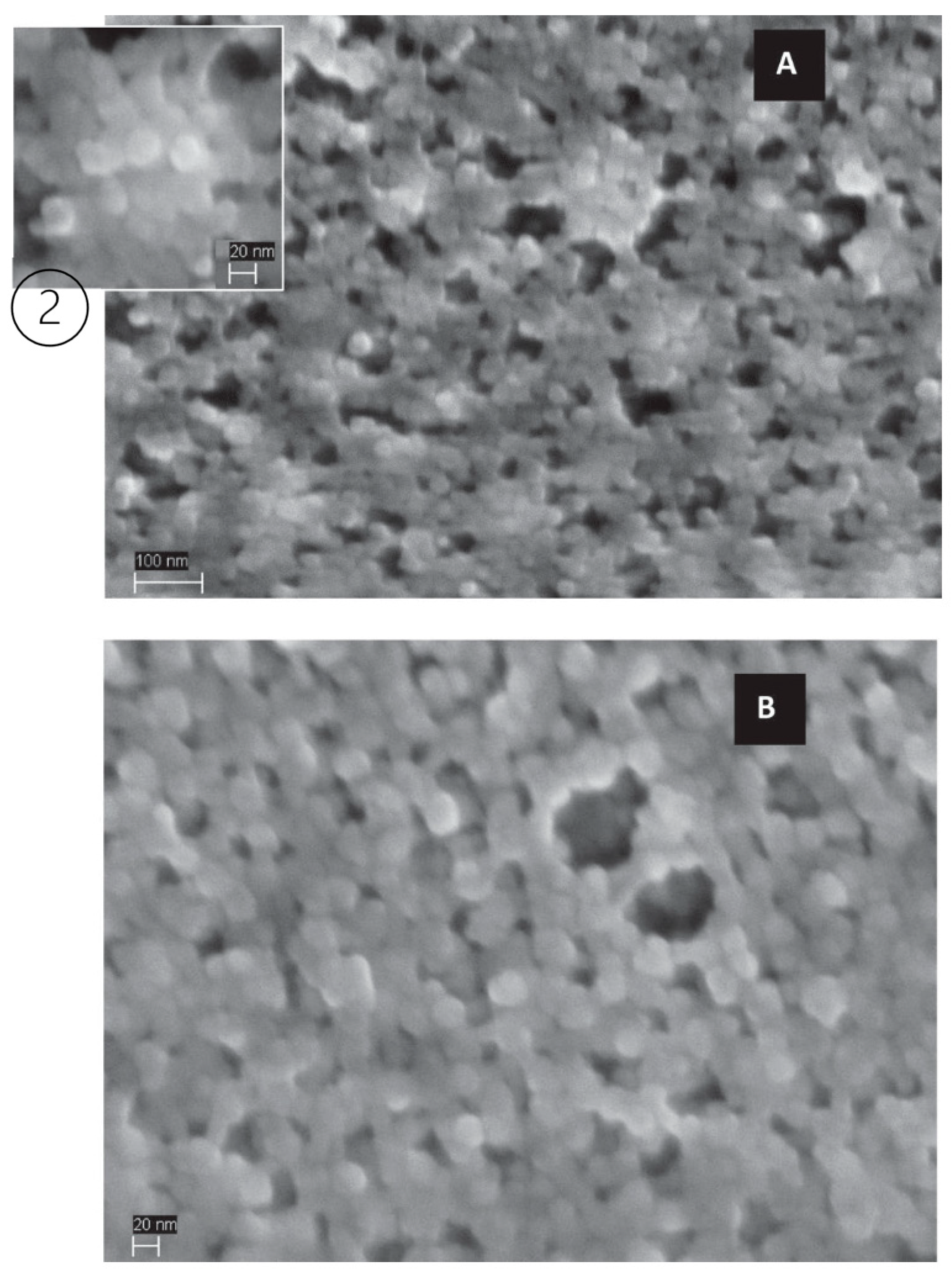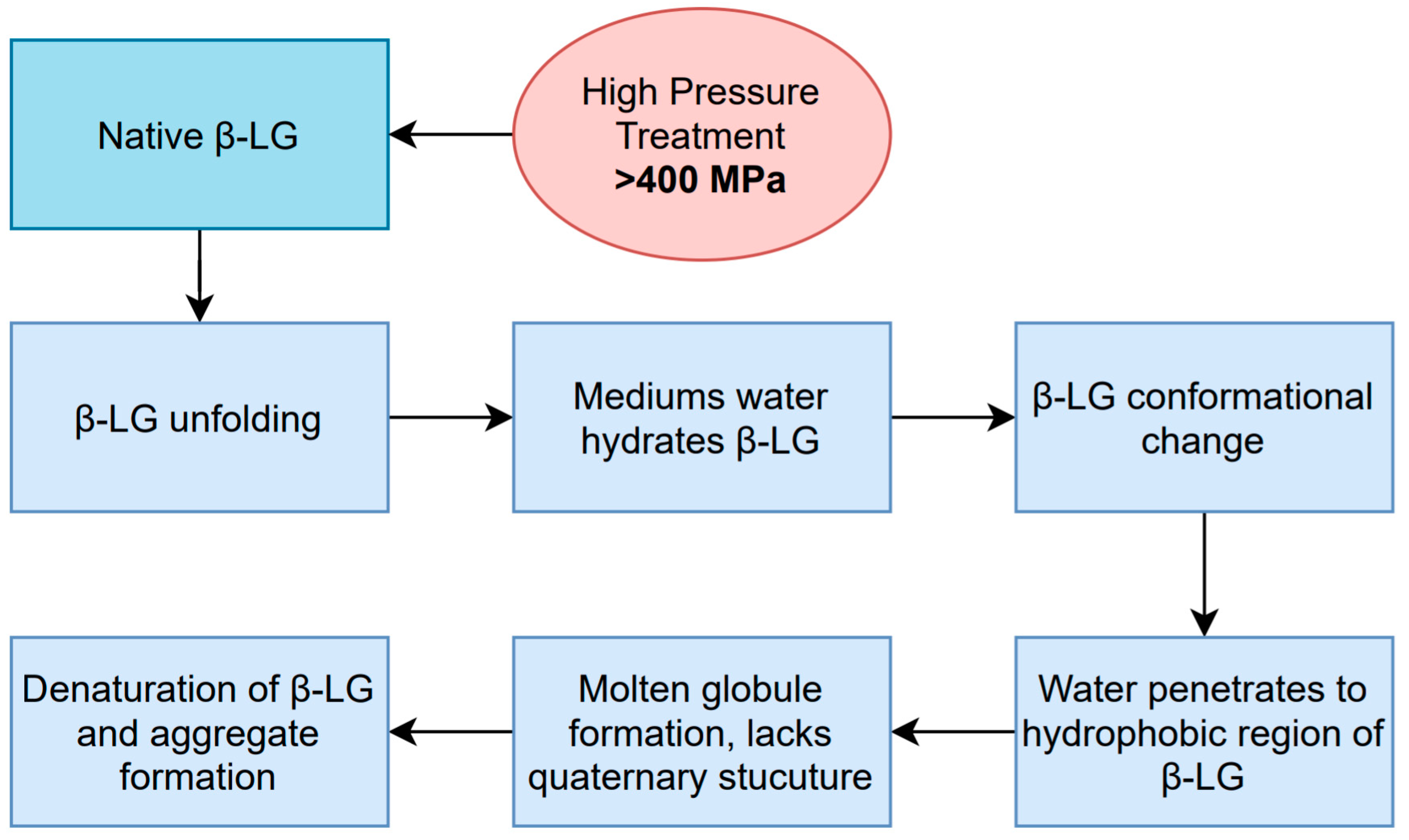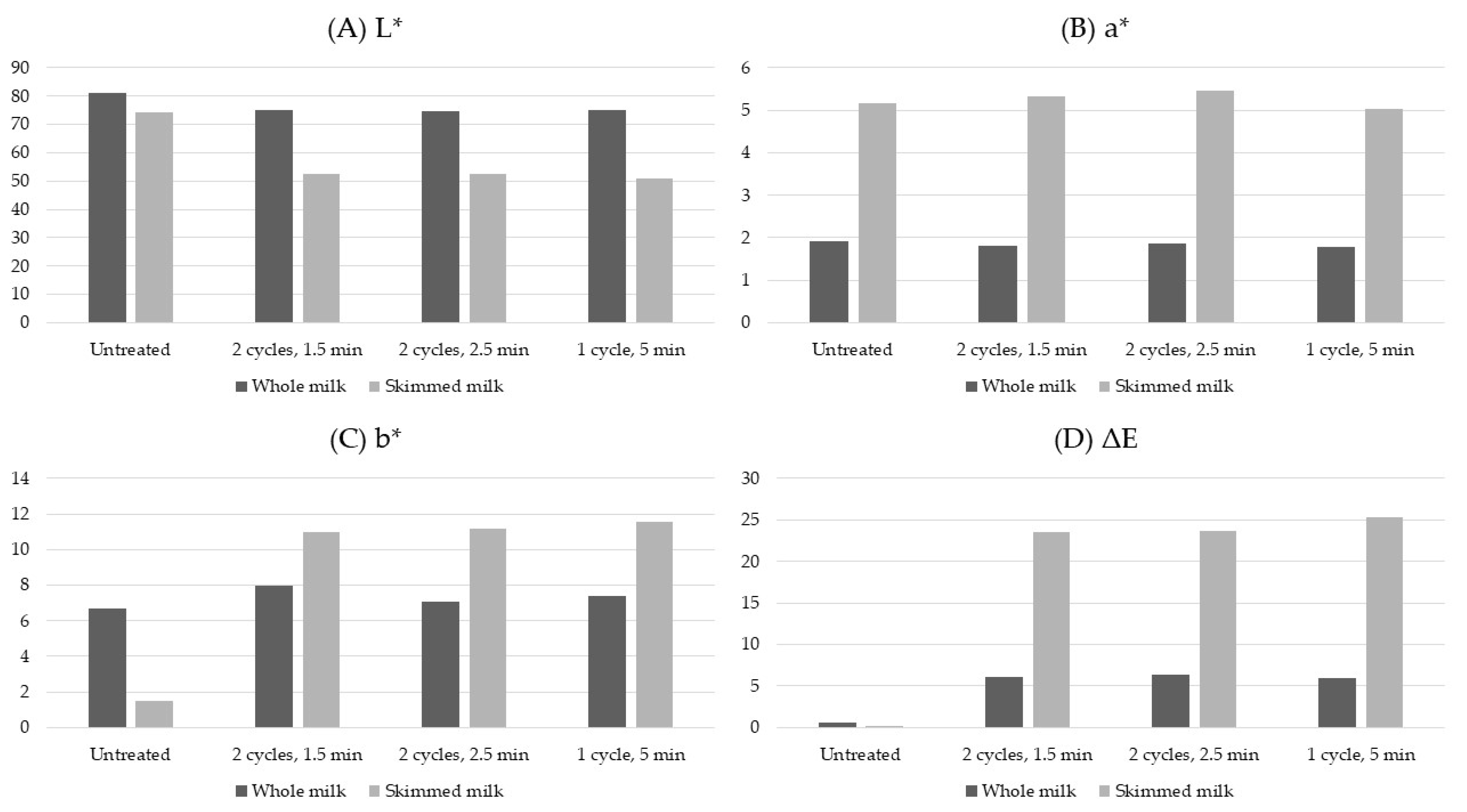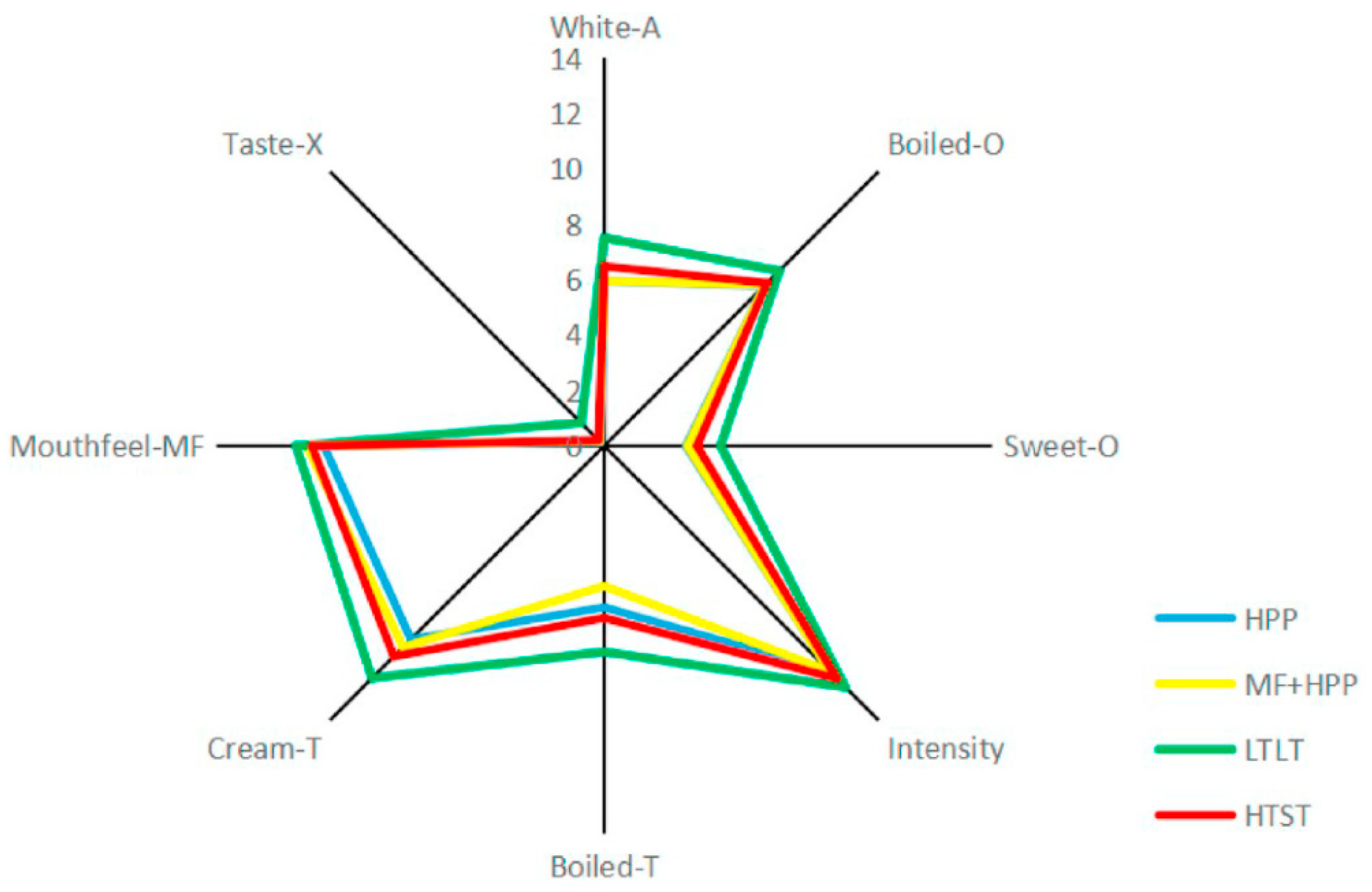3.1. Lipids
Triglycerides are the main fraction of milk lipids, accounting for up to 98% of the total concentration; diglycerides, monoglycerides, cholesterol, cholesterol esters, and free fatty acids make up most of the reminder of milk lipids [
28]. During processing, milk is standardized to have a specific fat content before commercialization; whole milk is considered to have around 3.25% fat, while skim or non-fat milk is relatively fat-free [
29]. Reduced-fat milk and low-fat milk that contain 2% and 1% fat, respectively, are other options of commercial milk [
29]. The effects of high-pressure processing on milk lipids have been studied: moderate and more intense pressure levels (250, 450, 550, 700, 800, and 900 MPa, for 5 min each) have been shown not to significantly change the quantity of triglycerides in milk; the concentration of diglycerides, monoglycerides, and free fatty acids also remains statistically similar [
30]. Additionally, it has been reported that intense-pressure treatment does not produce significant changes in polar lipid content and distribution, including phospholipids [
30]. A study [
31] about the effect of pulsed HPP on whole milk free fatty acid composition showed that when milk is subjected to two pulses of 600 MPa/1.5 min and 2.5 min, the amount of short-chain saturated fatty acids decreases, while that of medium-chain fatty acids slightly increases. Treatment at 600 MPa for 5 min in a single cycle showed an increase in short- and medium-chain fatty acids and a decrease in long-chain fatty acids.
In milk, the lipid content is distributed in fat globules, which are surrounded by a complex mixture of proteins, enzymes, phospholipids, triglycerides, and other compounds that together form a membrane known as the milk fat globule membrane, or MFGM [
32]. HPP has been shown to alter the size of fat globules and the composition of the MFGM. Pressure can slightly affect the size of fat globules; however, temperature parameters have a greater impact on size; processing milk at temperatures higher than 25 °C yields smaller fat globules, while the opposite is expected when using colder conditions [
1,
33,
34]. Ye et al. [
34] observed that whole milk subjected to 100–800 MPa promoted β-lactoglobulin (β-lg) association to the MFGM proteins through sulfhydryl disulfide interactions; increased association was promoted at higher pressures; similarly, κ-caseins and α-lactalbumin (α-la) can associate in lower quantities to the MFGM through the same interaction at pressures higher than 500 and 700 MPa, respectively. These changes and alterations to the MFGM’s composition modify its structure, stability, and integrity, as well as the milk’s properties, such as its emulsion capacity [
33].
Regarding milk fat globule size, in a study [
34] in which milk was subjected to different treatment conditions from 100 to 800 MPa, in 100 MPa increments for 30 min each, the average fat globule size was not affected when dispersed in buffer. In the previous study, treated milk samples were dispersed in either SDS/EDTA buffer or water to correctly evaluate their diameters. Fresh milk dispersed in buffer samples had an average particle diameter of 1.13 μm, which remained statistically similar after the eight different high-pressure treatments. Samples dispersed in water behaved differently, as an increase in diameter size was observed up to the 700 MPa treatment, whereas it remained constant with more intense treatments; this was attributed to the disruption of casein micelles, which reduced their contribution to the light-scattering effect. Similar results were observed in a more recent study [
35] on caprine raw milk treated at 200, 300, 400, and 500 MPa for 10 min at 20 °C and stored at 4 °C for 14 days. Immediately after treatment, all samples had statistically similar fat globule size diameters when compared to their raw milk counterparts; however, a dramatic increase in their size was observed after the 14-day storage for the untreated, 200, and 300 MPa samples. The mean diameters for the 400 and 500 MPa samples remained statistically the same as for the samples observed immediately after treatment. The authors determined that the fat globule size of milk subjected to 400 MPa or more remained unchanged even after cold storage. With the limited available information, the effect of HPP on the particle size of milk fat globules has been debated; Garcia-Amezquita et al. [
36] reported an increase in average diameter after treatments at 400 MPa for 15 and 20 min and 500 MPa for 5 and 10 min because of flocculation; meanwhile, as previously mentioned, other studies state that particle size could remain unaffected [
35]. Additional information and knowledge are required to determine the specific interactions and behavior of fat globules under high pressure, and how these affect them.
Considering the limited amount of available information regarding HPP and its effects on milk fat globules, a preliminary visual analysis of raw milk samples was conducted in our laboratory. A variety of raw and homogenized high-pressure-treated milk samples were observed via optical light microscope, followed by visual analysis and interpretation. As seen in
Figure 1, the sizes of fat globules between raw and homogenized milk are drastically different; the non-homogenized sample presented globules bigger in size, as expected. Regarding high-pressure-treated samples, similar patterns of globule distribution and size in the raw homogenized milk samples and those treated at 500 and 600 MPa were observed. The 400-MPa-treated samples presented fat globule agglomeration, and several globules were bigger in size, similar to those in raw, non-homogenized milk. These discrepancies between samples treated at different pressure intensities could lead to the separation of fat and a break in the emulsion stability, especially in those that are not subjected to homogenization, or are treated at mild pressure intensities. A commercial example milk with similar characteristics is Made by Cow—an Australian brand that offers “cold-pressed” milk subjected to HPP; they declare that their dairy products are not homogenized, and that consumers should expect a cream layer on top of the product composed of fat particles [
37]. Regarding milk fat globules, new information about the specific effects of HPP on their size, structure, and relationship with emulsion stability need to be generated. Additionally, the effects of high-pressure treatment on homogenized and non-homogenized samples could differ; specific information regarding the effects of independently subjecting milk to HPP is required, and the countereffects of homogenizing samples prior to processing could also be explored. This is especially relevant today, as the focus of studies on high pressure and milk has been on microbiology, and additional nutrients and compounds, such as proteins.
As mentioned previously, HPP itself has been shown to have very little to no effect on the lipid composition of milk; however, when it is processed at a mild pressure (250 MPa) without the aid of heat, enzymatic lipolysis is promoted. Lipolysis is caused by the enzyme lipoprotein lipase, which can be naturally present in raw milk or generated by bacteria during its storage. Lipolysis causes undesired flavors and aromas because of the release of free fatty acids, as well as the generation of mono- and diglycerides and additional volatile compounds [
38]. As previously mentioned, the effects of high pressure on milk lipids and fat globules need to be more deeply studied, especially because these changes have been related to changes in quality regarding emulsion stability in the final product.
3.2. Proteins
Milk proteins can be divided into two groups: whey proteins and caseins, which represent approximately 20% and 80% of the total protein content, respectively [
39]. Proteins are composed of a specific sequence of amino acids and stabilized by covalent bonds, electrostatic interactions, hydrogen bonds, disulfide bonds, hydrophobic interactions, and more [
10,
40]. These bonds have different susceptibilities to HPP; the weaker bonds are hydrogen and disulfide bonds; hydrophobic and electrostatic interactions are greatly affected, whereas covalent bonds remain intact after pressurization but thermal treatments greatly disrupt them [
4,
10,
11]. The proteins are arranged in four different sequential levels—primary, secondary, tertiary, and quaternary structures—which are folded differently, and have distinct types of bonds and interactions. Protein denaturation, which can be caused by HPP, alters the native structure of proteins by causing unfolding and damaging different bonds and interactions; these changes in milk proteins also cause alterations to functionality and properties [
10,
40]. The protein structures that are widely affected by HPP are the quaternary, tertiary, and secondary structures, because of the presence of weaker types of bonding; primary structures are virtually unaffected because of the presence of covalent bonds [
10].
Casein micelles and whey proteins are two of the most frequently studied components in milk, because of their nutritional properties, functionalities, and characteristics, such as color and turbidity, rheological properties, pH, and emulsion stability. Regarding their structure, composition, and size, these proteins have been extensively studied, and the changes caused by different processing methods, including high pressure, are relevant because of the alterations to the specific properties of milk and dairy products, including hydration and acidification, among others [
41,
42].
Caseins are hydrophobic proteins, and possess a high charge; there are four different types: α
s1-, α
s2-, β-, and κ-caseins. These different caseins can bind together in the presence of calcium phosphate to generate a colloidal aggregate known as a casein micelle, which has a diameter in the range of 50 − 300 nm, is composed of approximately 6% inorganic matter in dry weight, and is highly hydrated [
39,
41,
42]. The exact composition and structure of casein micelles is disputed and under debate, for which they have been extensively studied. Bhat et al. [
41] summarized three distinct models for their classification: the coat–core model, sub-micellar model, and internal structure model; the first model explores how the outer coating and internal structure of micelles are composed differently, the second model dictates how rough spherical subunits make up the casein micelles, and the third model indicates the process by which caseins can aggregate differently.
The most prominent whey proteins are β-lactoglobulin (β-lg), α-lactalbumin (α-la) and, to a lesser extent, bovine serum albumin (BSA), immunoglobulins (IG), bovine lactoferrin (BLF), bovine lactoperoxidase (LP), and minor amounts of glycomacropeptide (GMP); these proteins are soluble at a pH of 4.6 [
39,
43]. These globular proteins have a predominant helical structure, which can be partially unfolded during milk processing, causing denaturation [
44]. Furthermore, enzymes are also an important fraction of the proteins in milk, and are impacted by high pressure. From a technological standpoint, enzymes are used to determine milk quality regarding deterioration and preservation, indicators for pasteurization, detection of mastitis infection, and antimicrobial activity [
45].
3.2.1. Casein Micelles
Casein micelles undergo structural changes in their size, composition, and hydration during HPP treatments; however, the specific changes, and their extent, depend on the treatment conditions the milk was subjected to. During HPP, water is compressed, which causes a disruption in the hydrophobic bonding of the casein micelles’ components; this changes the light transmission properties of milk, and minerals are solubilized—mainly micellar calcium phosphate [
7,
10,
39,
42,
46,
47,
48]. Mineral solubility and ionization are favored under high-pressure conditions; the compacted water molecules penetrate and hydrate the molecule, causing a dissociation of ion pairs that leads to a release of calcium phosphate and physical changes in the casein micelles [
10,
39,
47]. The changes in mineral solubility, alongside additional internal and external factors such as the presence of denatured whey proteins, temperature, pH, and milk composition, cause disassociations of casein micelles; however, reassociation is possible during storage, depending on the level of pressure applied [
39,
47]. A diagram and summary of the process and changes occurring to casein micelles is depicted in
Figure 2. Milk subjected to high-pressure treatments undergoes two important changes: firstly, an increase in the negative charge of the molecule due to the association of denatured β-Lg, and secondly, the disruption of the micelle into the four different casein molecules; these changes increase the molecules’ hydration and solubility [
10].
The size of casein micelles is greatly affected by HPP; the extent and type of the changes are determined by the treatment conditions. Pressures greater than 300 MPa cause an irreversible decrease in casein micelle size, attributed to micelle fragmentation. Milder pressures of approximately 250 MPa may increase the size of micelles because of the interaction between denatured β-Lg and κ-casein; however, these changes can be reversible [
10,
39,
49]. Temperature and pH also contribute to micelle size changes during processing; temperature enhances size increments alongside higher pH levels [
10,
39,
49].
Table 2 summarizes some reported changes in the size of casein micelles at different treatment conditions. In general, pressure treatments lower than 200 MPa have no effect on particle size; however, incrementing the pressure intensity tends to yield smaller micelles. Nevertheless, applying the most intense treatments eventually leads to an irreversible decrease in their size. These changes are mainly caused by the intensity of pressure treatment, whereas treatment time and temperature do not impact changes in size significantly.
A study [
13] performed with whole milk processed at 600 MPa, in which casein size was analyzed with Zetasizer, showed that low-temperature low-time (LTLT), high-temperature short-time (HTST), and HPP samples had z-values of 222, 247, and 140 nm, respectively, concluding that casein particle size was significantly smaller in the high-pressure-treated samples when compared to heat-treated milk. The previous results indicate that the changes to casein micelle size are exacerbated by intense pressure treatment; temperature did not have as significant an impact even when two different conditions were analyzed. Similarly, Iturmendi et al. [
51] studied the effects of subjecting 4 and 8% micellar casein concentrates (MCCs) to 300, 450, and 600 MPa for 5 min on casein size; the results were compared to untreated control samples. It was found that for the 4% concentrate the control-, 300-, 450-, and 600-MPa-treated samples had a z-average of 186, 167, 129, and 101 nm, respectively, and for the 8% concentrate had z-values of 193, 185, 162, and 167 nm, respectively. In general, size reduction increased alongside increasing pressure treatment and intensity. These authors also attributed loss of brightness and an increase in the transparency of the samples to the decrease in casein particle size; additionally, the samples subjected to 600 MPa revealed that the particles reaggregated; however, this change was more prevalent for the samples with lower micellar casein concentration, because of the increased presence of micellar calcium phosphate.
A commonly used study to visually evaluate casein micelle surface structure, shape, and size is electron microscopy. Scanning electron microscopy (SEM) yields different images or micrographs that help to determine differences in casein micelles. The microstructure, shape, and size of casein micelles’ micrographs has been observed in pressure-treated milk samples and compared to their untreated counterparts, revealing changes and alternations in these parameters; different examples of casein micelles are shown in
Figure 3,
Figure 4 and
Figure 5 [
48,
49,
52].
In
Figure 3, it can be observed that after the application of 500 MPa, casein micelles had an average size of 20 nm, while for the untreated samples it was 200 nm [
48]. In
Figure 4, casein micelles with rough spherical shapes are observed, and casein subunits are also depicted at the micelles’ surface; moreover, possible dissociated casein micelle fragments can be observed in the backgrounds of both images; the rightmost image also depicts a smaller, dissociated casein micelle, and the presence of links to other fragments [
49]. In
Figure 5, untreated casein and protein concentrates show nearly perfect spherical shapes, with an average diameter of 200 nm; after the 450-MPa treatment, the spherical shape became irregular, structural integrity was lost alongside a diminution in size, and a network of 20-nm aggregates was formed [
52]. As observed and explained, high-pressure treatments severely affect and change the size and structure of casein micelles; these changes have been determined as the cause of additional effects on milk properties, such as changes in color and stability, rheological properties, pH, and more.
3.2.2. Whey Proteins
Milk proteins are affected differently by high-pressure treatments. As was previously mentioned, the primary structure of proteins is mainly composed of covalent bonds, which are virtually unaffected by HPP; however, their secondary and tertiary structures have hydrophobic, electrostatic interactions and hydrogen bonds, which can be disrupted by this process. This means that whey proteins are more susceptible to unfolding or denaturation [
47]. The two most abundant whey proteins are α-lactalbumin (α-LA) and β-lactoglobulin (β-LG); α-LA is more stable and resistant to HPP—it has a more rigid structure attributed to four intramolecular disulfide bonds and a lack of thiol groups—whereas β-LG is more susceptible to HPP: its structure is characterized by two intramolecular disulfide bonds and one free thiol group [
1,
39,
47]. The sensitivity to pressure of β-LG can be explained by a denaturation model; this process starts with a reversible unfolding caused by pressure, which allows the water molecules in the medium to penetrate the hydrophobic regions hydrating the molecule, followed by a change in the proteins’ conformation similar to a molten globule and, finally, the denaturation forms aggregates [
47]. This process is summarized in
Figure 6.
Immunoglobulins (IGs) and bovine serum albumin (BSA) are whey proteins present in milk in smaller concentrations. IGs are relatively sensitive to HPP; however, BSA is believed to be more pressure resistant because of its structure, which has 17 desulfated bonds and a high quantity of α-helices [
47,
53,
54].
Table 3 summarized the effects of different pressure intensities on the denaturation of whey proteins; based on this information, the most sensitive and susceptible whey protein to HPP is β-LG, followed by IG, BSA, and α-LA. As shown, each type of whey protein has different susceptibility to pressurization and, depending on the intensity of the treatment applied, will show a different extent of denaturation and the changes in the treated milk. Different thresholds are shown that indicate the degree of denaturation of different whey proteins when subjected to distinct pressure intensities.
A report [
13] on protein denaturation in whole milk subjected to 600 MPa for 5 min and compared to two pasteurization methods—LTLT (63 °C for 30 min) HTST (72 °C for 15 s)—revealed differences between samples. Bovine lactoferrin (BLF), BSA, IG, and all four different casein types remained statistically similar between the three samples; however, a significant decrease in the quantities of α-LA (6% denaturation degree) and β-LG (41 to 59% denaturation degree) was observed in the high-pressure-treated samples.
The changes and alterations in whey protein structures produced by high-pressure treatment promote some specific improvements in the functionality of milk, such as hydrophobicity, solubility, gelation, hardness, and emulsifying properties [
1]. These changes may improve the quality during additional dairy product manufacturing, such as in cheese and yogurts.
3.2.3. Enzymes
Specific enzymes present in milk are associated with stability loss and decreasing shelf life in raw and treated milk. The presence of psychrotrophic bacteria in milk causes the generation of heat-resistant proteolytic and lipolytic enzymes, which hydrolyze proteins and fat, causing undesirable flavors [
55]. Alkaline phosphatase (ALP) and lactoperoxidase (LPO) are two of the most relevant enzymes in the milk industry, as they are traditionally used as process indicators for the efficacy and safety of thermal treatment or pasteurization [
56]. Lipase is an enzyme that can naturally be present in raw milk; these enzymes degrade triglycerides into free fatty acids, monoglycerides, and diglycerides, which spoils the milk because of the undesirable aromas and flavors that are generated during this process [
57].
High-pressure treatment has a dual effect on enzymes; depending on the pressure intensity, type of enzyme, and the temperature, enzymes can be activated or inhibited. Pressures lower than 350 MPa could increase the enzymatic activity because of conformational flexibility in enzymes and substrate proteins’ partial unfolding, which foments their interactions [
47]. Pressures higher than 400 MPa are known to begin inactivation, which can increase alongside incrementing pressure. However, the extent of inactivation is influenced not only by the pressure level, but also by the treatment time, enzyme type, milk composition, and pH levels [
7,
16,
47]. All of these factors play a role in the varying sensitivity of the enzymes present in milk to high pressure.
ALP resists pressure treatments up to 400 MPa; however, inactivation levels of 50% can be achieved at 500 MPa for 90 min or 600 MPa for 10 min, and a complete inactivation at 800 MPa for 8 min [
54,
58]. Additional indigenous enzymes—γ-glutamyl transferase (GGT), phosphohexose isomerase (PHI), and LPO—have been found to be resistant to pressures up to 400 MPa [
7,
54,
56]. However, Munir et al. [
47] summarized that GGT, PHI, and ALP are only partially inactivated at 350, 400, and 600 MPa, respectively, and completely inactivated at a pressure levels of 550, 630, and 800 MPa, respectively. Janahar et al. [
59] ascertained that the lipase activity in milk samples subjected to 400 MPa during the come-up time (CUT) was statistically similar to that in untreated milk, while the sample subjected to the same pressure, but for 3 min, showed a significant increase.
A study [
56] evaluated the effects of high-pressure treatments on the inactivation of the indigenous milk enzymes alkaline phosphatase, γ-glutamyl transferase (GGT), and phosphohexose isomerase (PHI). ALP presented the highest resistance to pressure, followed by GGT and PHI. A complete inactivation of GGT was observed at 600 MPa/20 °C/30 min; moreover, PHI presented an almost complete inactivation when subjected to 500 MPa/20 °C/15 min. According to these authors, ALP was the most baroresistant enzyme, as an extensive inactivation (99%) required a pressure of 650 MPa or higher. In addition, ALP is known to reactivate during cold storage in thermally treated milk; this same pattern was seen for milk samples after pressure treatment, regardless of the initial enzyme inactivation [
56]. Enzymes are among the most important components of milk, as they influence shelf life and stability. As shown in
Table 4, the resistance to HPP of different enzymes differs from one another, and complete inactivation can sometimes be unachievable even with the most intense treatments.
3.4. Minerals
As previously mentioned, the presence colloidal calcium phosphate, alongside hydrophobic interactions and hydrogen bonds, gives stability and structure to casein micelles [
47]. HPP causes micelles to disaggregate and alters the mineral distribution of milk, increasing ionic calcium concentration [
47,
60]. The changes to calcium because of HPP alter additional physicochemical and functional properties of milks and derived dairy products, as explained in
Section 4. In addition, phosphorus and magnesium are also found in casein micelles; disrupting and destabilizing these molecules causes mineral solubilization. Potassium and sodium may also present minimal changes, and can be found in the aqueous phase of milk [
52]. Salt—an important component in dairy products such as cheese—undergoes changes because of HPP, causing a more efficient retention and improving its distribution in the final product [
1].
A study [
52] was conducted utilizing MCC and milk protein concentrates (MCPs), and a soluble mineral analysis was realized by evaluating the calcium-to-phosphorus ratio. Untreated samples had a ratio of 1:1, which increased after a treatment at 350 MPa for 15 min to 1:4; however, the 450-MPa treatment yielded a smaller ratio. The difference in results was attributed to the reassociation of α
S1-casein, α
S2-casein, and calcium, making them insoluble once more; nevertheless, the more intense pressure treatment still presented a higher ratio than the untreated samples.
